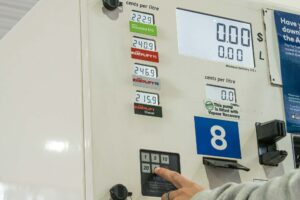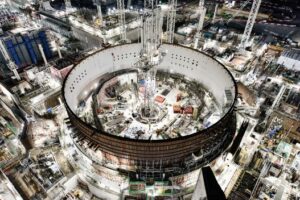And then, in a single bound, it was back to small modular reactors. The federal Coalition’s confused nuclear power policy has lurched from SMRs to large scale nuclear and back again to SMRs. It’s as if the policy is decided by the nuclear lobbyist most recently consulted.
Coalition leader Peter Dutton’s latest thought bubble on nuclear, dutifully reported in The Australian newspaper last weekend, is that Australia should sign up to SMRs, and should be able to build the first of them by the middle of the 2030s – faster than even most of the technology’s boosters admit is possible.
Dutton says the new plan will be fully sketched out before the federal Labor government’s budget in early May – and according to The Australian this latest plan follows meetings last week with executives of Rolls Royce SMR and its Australian partner Penske.
Renew Economy decided to check all this out with Rolls Royce SMR itself, and got some surprising answers.
“It wasn’t a representative of ours (who met with Peter Dutton),” a company spokeswoman said by email. “I believe it was a potential partner of ours that met with Peter Dutton who spoke about RR SMR on our behalf.”
Dutton and other Coalition boosters like to talk about SMRs in the present tense, and most mainstream media dutifully follow suit, as if they are already operating.
This is deception. A group of my friends chatting over coffee this week was stunned to hear that SMRs are not actually a thing, despite what they read in the press. A few smaller nuclear reactors exist, such as in China and Russia, but they are in no way modular, which is the supposed key selling point of this new technology.
“One of the biggest problems for SMRs is that they don’t exist,” Allison Macfarlane, director of the school of public policy and global affairs at the University of British Columbia and a former chair of the US Nuclear Regulatory Commission, told the Financial Times this week.
“We’re still at the paper stage, the computer model stage. To get to demonstration models and then a full-scale model when you are ready to commercialise will take billions of dollars,” she added.
Rolls Royce SMR is still at least two years away from obtaining a licence, and the spokesperson told Renew Economy this week that the company is hopeful that the first SMR can be completed “in the early 2030s.”
However, Simon Bowen, the chair of Great British Nuclear, the government agency that is trying to lead the technology’s revival and find ways to replace its existing ageing fleet, told the FT this week the first SMR won’t likely be seen until the mid 2030s.
That time line is important, because it goes to the fantasy nature of the Coalition’s nuclear policy. Is Dutton seriously suggesting that Australia, with no civil nuclear power industry, can match the UK on timing on their proprietary nuclear technology.
And first-of-their-kind technologies are always considerably more expensive than those that follow. But more on the timing later, because that goes to the heart of what the Coalition is trying to do – not so much build nuclear, but to stop renewables in their tracks.
But it is impossible to think that Australia would commit to an SMR before it is built in its host country, with all the embedded infrastructure and know-how. And no country is going to commit to more SMRs until the first one is built, and can prove itself. Which straightaway pushes the Coalition timeline back into the 2040s.
On costs, Dutton is trying to convince everyone that nuclear – contrary to all available evidence – is low cost, which The Australian, unsurprisingly, reported as a matter of fact.
The Coalition’s energy spokesman Ted O’Brien engages in some impressive verbal calisthenics by claiming that they might be expensive for investors, but are low cost for consumers.
But if new-build nuclear is to be low cost to consumers it will be the result, as it is in France, of massive government subsidies. And given the Coalition’s horrified reaction to Labor’s “Made in Australia” green manufacturing plan, they are definitely not in favour of government subsidies.
The Australian reported that the Rolls Royce SMR is priced at around $5 billion for a 470 MW facility, which appears an heroic assumption given it is less than one third of the price of the only SMR to actually obtain a licence to date, the NuScale project in the US that was cancelled last year because it was too expensive for consumers.
Rolls Royce SMR’s own web page describes a study produced last year that claimed its technology could reduce wholesale prices in the UK by between three per cent and 13 per cent, depending on how many SMRs were rolled out.
Curiously, the study – according to the detailed Rolls Royce summary of it – arrives at these numbers by comparing SMRs to the cost of peaking gas plants, the most expensive generation on the grid, and which – in reality – is rarely used. They are only switched on around 1 to 2 per cent of the time.
These peaking gas plants are not seen as the usual competitor to nuclear or SMRs, because nuclear is designed to be baseload, not the fast response and flexible capacity needed to fill in the gaps of a grid dominated by wind and solar.
And, it should be noted, nuclear itself is highly dependent on fast-response capacity – peaking gas and pumped hydro – to make up for its own lack of flexibility.
The Rolls Royce spokesperson told Renew Economy that this analysis was conducted in the winter of 2022/23, when the energy crisis was at its worst, gas prices had soared, and energy consumers were being hit by huge bills.
It begs a question, which Rolls Royce didn’t answer: If SMRs are only able to undercut peaking gas power plant prices by a small amount, what does that imply when those costs are spread across the whole day?
The spokesperson confirmed that Rolls Royce SMRs will indeed be focused on “baseload” power, and its SMRs are designed not to displace renewables, but replace “the loss in low-carbon electricity … caused by our ageing existing reactor fleet going offline in the years ahead.”
The spokesperson said SMRs do have a degree of flexibility to load follow and respond “when the wind doesn’t blow and the sun doesn’t shine,” and can use its thermal output to produce hydrogen or process heat, which might be attractive in the northern hemisphere.
But they have little ability to ramp up to fill in gaps of wind and solar because, as the spokesperson told Renew Economy in their email: “SMRs work most cost-effectively when ‘always on’.”
And this is important because it goes to the heart of why the Coalition nuclear plan makes absolutely no sense and is more about destruction of one industry, rather than construction of another.
Australia is heading towards 82 per cent renewables by 2030, and even if it doesn’t meet that deadline, it will be above 90 per cent by the mid 2030s, and likely close to 100 per cent.
A fleet of “always on” nuclear power plants will struggle to find a role in that scenario, particularly as daytime demand will be almost entirely met by the anticipated ongoing boom in small-scale solar on the roofs of household and business consumers.
But the Coalition policy, and it makes no secret of this, is not about compatibility. O’Brien’s own energy advisor admits that nuclear and renewables are effectively an “either-or” because the system is either going to be baseload or renewables and storage.
And the Coalition’s fundamental stand is that it refuses to believe that wind and solar can power a modern economy. “The lights will go out,” says Dutton, or “your fridge goes off at home” he added this week.
Which is why they are calling for a moratorium on the roll out of wind, solar, battery storage and transmission, and why they want coal-fired power stations to stay open until nuclear can arrive.
And it’s why their proxies in the mainstream and social media – and so-called think tanks and ginger groups backed by billionaires such as Gina Rinehart and Trevor St Baker – spend so much time demonising the technologies that are currently available, and which can do the job, such as solar, wind, battery storage and electric vehicles.
Dutton’s rhetoric is also liberally splattered with outright falsehoods. A check of his media transcripts this week reveals a number of common false statements.
The first is the claim that Australia is the only OECD country not to have or want nuclear. Not true. Germany closed down the last of its nuclear generators a year ago, and Italy voted against the technology in a referendum a decade ago after shutting down the last of its reactors. A number of other EU countries are following suit.
Dutton also claims that the federal government is planning “28,000 kms of new transmission lines by 2030.” Again, not true. The Australian Energy Market Operator’s Integrated System Plan models 10,000km by 2030 in its core step change plan. That’s still a lot, but little more than one third of what Dutton claims.
The 28,000km number is a 2050 target, not 2030, and only in the scenario where Australia becomes a renewable energy superpower by exporting green hydrogen and other green products, most likely from vast wind and solar projects in the middle of the country that will need to link into the grids or production facilities.
Dutton says he wants to have a “mature” discussion about the energy mix. But that can’t happen if his rhetoric is based around obvious lies.








